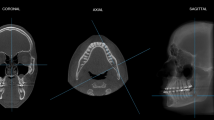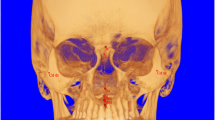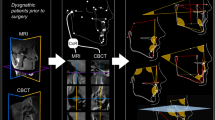Abstract
Background
Children with orofacial deformity may require repeated imaging of the facial skeleton.
Objective
To test the feasibility and accuracy of “black bone” magnetic resonance imaging (MRI) for assessing facial deformity in children.
Materials and methods
Three-dimensional (3-D) black bone gradient echo sequences (flip angle 5°, submillimetre spatial resolution) from 10 children (median age: 13 years, range: 2–16 years), who underwent MRI of the temporomandibular joints, were evaluated with multiplanar reconstruction and 3-D rendering tools. Intra- and inter-reader agreement was investigated for measuring the height of the mandibular ramus and condyle, basal length of the mandible, gonion angle and mandibular inclination angle by intraclass correlation coefficient (ICC) and Bland–Altman analysis. Absolute percentage error was calculated with the average of all measurements serving as reference.
Results
Sixty linear and 40 angle measurements were obtained on reformatted multiplanar black bone images with excellent inter-reader agreement (ICC > 0.99, agreement bias < 1.4 mm/ < 1.5°) and small error (median absolute error < 3%). The black bone images required inversion of the signal intensity and removal of air before they could be processed with standard volume rendering tools. The diagnostic utility of 3-D views for assessing the facial skeleton was sufficient except for assessing dental relationship.
Conclusion
Morphometric measurements of the mandible can be obtained from black bone MRI with comparable inter-rater agreement to that reported for cone beam computed tomography (CT). With improvements of 3-D rendering techniques and software, black bone MRI may become a radiation-free alternative to CT in children with facial deformities.



Similar content being viewed by others
References
Saurenmann RK, Rose JB, Tyrrell P et al (2007) Epidemiology of juvenile idiopathic arthritis in a multiethnic cohort: ethnicity as a risk factor. Arthritis Rheum 56:1974–1984
Larheim TA, Doria AS, Kirkhus E et al (2015) TMJ imaging in JIA patients—An overview. Semin Orthodontics 21:102–110
Larheim TA, Haanaes HR, Ruud AF (1981) Mandibular growth, temporomandibular joint changes and dental occlusion in juvenile rheumatoid arthritis. A 17-year follow-up study. Scand J Rheumatol 10:225–233
Stabrun AE (1991) Impaired mandibular growth and micrognathic development in children with juvenile rheumatoid arthritis. A longitudinal study of lateral cephalographs. Eur J Orthod 13:423–434
Rönning O, Barnes SA, Pearson MH, Pledger DM (1994) Juvenile chronic arthritis: a cephalometric analysis of the facial skeleton. Eur J Orthod 16:53–62
Kjellberg H, Fasth A, Kiliaridis S et al (1995) Craniofacial structure in children with juvenile chronic arthritis (JCA) compared with healthy children with ideal or postnormal occlusion. Am J Orthod Dentofacial Orthop 107:67–78
Glerup M, Stoustrup P, Matzen LH et al (2020) Longterm outcomes of temporomandibular joints in juvenile idiopathic arthritis: 17 years of followup of a Nordic juvenile idiopathic arthritis cohort. J Rheumatol 47:730–738
Kellenberger CJ, Arvidsson LZ, Larheim TA (2015) Magnetic resonance imaging of temporomandibular joints in juvenile idiopathic arthritis. Semin Orthod 21:111–120
Kuseler A, Pedersen TK, Gelineck J, Herlin T (2005) A 2 year followup study of enhanced magnetic resonance imaging and clinical examination of the temporomandibular joint in children with juvenile idiopathic arthritis. J Rheumatol 32:162–169
Muller L, Kellenberger CJ, Cannizzaro E et al (2009) Early diagnosis of temporomandibular joint involvement in juvenile idiopathic arthritis: a pilot study comparing clinical examination and ultrasound to magnetic resonance imaging. Rheumatology (Oxford) 48:680–685
Kellenberger CJ, Junhasavasdikul T, Tolend M, Doria AS (2018) Temporomandibular joint atlas for detection and grading of juvenile idiopathic arthritis involvement by magnetic resonance imaging. Pediatr Radiol 48:411–426
Tolend MA, Twilt M, Cron RQ et al (2018) Toward establishing a standardized magnetic resonance imaging scoring system for temporomandibular joints in juvenile idiopathic arthritis. Arthritis Care Res (Hoboken) 70:758–767
Stoustrup P, Resnick CM, Pedersen TK et al (2019) Standardizing terminology and assessment for orofacial conditions in juvenile idiopathic arthritis: international, multidisciplinary consensus-based recommendations. J Rheumatol 46:518–522
Abramowicz S, Cheon JE, Kim S et al (2011) Magnetic resonance imaging of temporomandibular joints in children with arthritis. J Oral Maxillofac Surg 69:2321–2328
Kellenberger CJ, Abramowicz S, Arvidsson LZ et al (2018) Recommendations for a standard magnetic resonance imaging protocol of temporomandibular joints in juvenile idiopathic arthritis. J Oral Maxillofac Surg 76:2463–2465
Karlo CA, Patcas R, Kau T et al (2012) MRI of the temporo-mandibular joint: which sequence is best suited to assess the cortical bone of the mandibular condyle? A cadaveric study using micro-CT as the standard of reference. Eur Radiol 22:1579–1585
Eley KA, McIntyre AG, Watt-Smith SR, Golding SJ (2012) “Black bone” MRI: a partial flip angle technique for radiation reduction in craniofacial imaging. Br J Radiol 85:272–278
Eley KA, Watt-Smith SR, Golding SJ (2012) “Black bone” MRI: a potential alternative to CT when imaging the head and neck: report of eight clinical cases and review of the Oxford experience. Br J Radiol 85:1457–1464
Lethaus B, Gruichev D, Gräfe D et al (2020) “Black bone”: the new backbone in CAD/CAM-assisted craniosynostosis surgery? Acta Neurochir (Wien) 163:1735–1741
Saarikko A, Mellanen E, Kuusela L et al (2020) Comparison of Black Bone MRI and 3D-CT in the preoperative evaluation of patients with craniosynostosis. J Plast Reconstr Aesthet Surg 73:723–731
Tan AP (2019) MRI protocol for craniosynostosis: replacing ionizing radiation-based CT. AJR Am J Roentgenol 213:1374–1380
Wiesinger F, Sacolick LI, Menini A et al (2016) Zero TE MR bone imaging in the head. Magn Reson Med 75:107–114
Stoustrup P, Iversen CK, Kristensen KD et al (2018) Assessment of dentofacial growth deviation in juvenile idiopathic arthritis: Reliability and validity of three-dimensional morphometric measures. PLoS One 13:e0194177
Markic G, Muller L, Patcas R et al (2015) Assessing the length of the mandibular ramus and the condylar process: a comparison of OPG, CBCT, CT, MRI, and lateral cephalometric measurements. Eur J Orthod 37:13–21
Suchyta MA, Gibreel W, Hunt CH et al (2018) Using black bone magnetic resonance imaging in craniofacial virtual surgical planning: a comparative cadaver study. Plast Reconstr Surg 141:1459–1470
Author information
Authors and Affiliations
Corresponding author
Ethics declarations
Conflicts of interest
None
Additional information
Publisher's Note
Springer Nature remains neutral with regard to jurisdictional claims in published maps and institutional affiliations.
Rights and permissions
About this article
Cite this article
Kupka, M.J., Aguet, J., Wagner, M.M. et al. Preliminary experience with black bone magnetic resonance imaging for morphometry of the mandible and visualisation of the facial skeleton. Pediatr Radiol 52, 951–958 (2022). https://doi.org/10.1007/s00247-021-05257-8
Received:
Revised:
Accepted:
Published:
Issue Date:
DOI: https://doi.org/10.1007/s00247-021-05257-8




